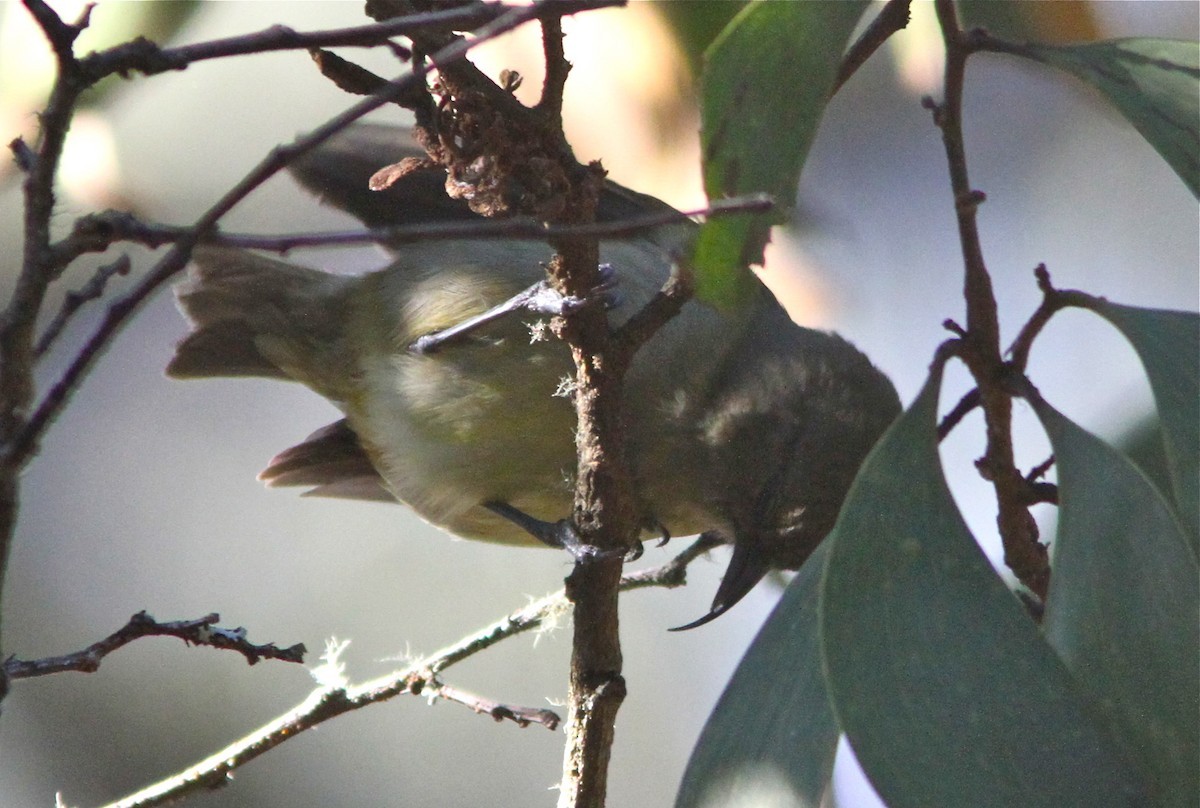Akiapolaau
A species of Nukupuus and akiapolaau Scientific name : Hemignathus wilsoni Genus : Nukupuus and akiapolaau
Akiapolaau, A species of Nukupuus and akiapolaau
Botanical name: Hemignathus wilsoni
Genus: Nukupuus and akiapolaau
Content
Description General Info
 Photo By Don Roberson
Photo By Don Roberson Description
The ʻakiapōlāʻau (Hemignathus wilsoni), pronounced ah-kee-ah-POH-LAH-OW, is a species of Hawaiian honeycreeper that is endemic to the island of Hawaii. Its natural habitats are dry and montane moist forests, and the only bird species on the island to occupy the woodpecker niche. The bird is 5.5 inches (14 cm) in length, and has an unusually curved beak-(a specialist species). The ʻakiapolaʻau is a pudgy bird which has a whitish bottom and tail, black legs, yellow chest, orangish head, black face mask and bill and gray black wings. The male's song is either a loud, short pit-er-ieu or a rapid warba-warba. Its various calls include an upslurred whistle, a short cheedle-ee warble, and a short sweet. Due to the recent disappearance of the Maui and Kauai nukupu'us in the 1990s, leading to fears that they may be extinct, the ʻakiapōlāʻau may be the last of its genus. It is the only member of the subgenus Heterorhynchus, which has a woodpecker-like feeding habitat and exclusively preys on insects, in contrast to the nukupu'us, which were both insect-eaters and also hummingbird-like nectarivores. 
Size
13 - 23 cm
Life Expectancy
13 years
Nest Placement
Tree
Feeding Habits
Akiapolaau, with its specialized beak, adeptly extracts insects and larvae from wood, supplements its diet with nectar, and forages for invertebrates, demonstrating a diverse and adaptive feeding repertoire.
Habitat
The akiapolaau occupies montane regions, specifically thriving in Koa/‘Ohi‘a Montane Mesic Forests and Montane Wet Forests, at elevations of 500 to 1,500 meters. It favors closed canopy forests with native tree species and can also be found in Subalpine Dry Forests with open savanna-like areas. The akiapolaau's habitat is fragmented but remains centered on environments with indigenous vegetation.
Dite type
Nectivorous
General Info
Feeding Habits
Bird food type
Distribution Area
The ʻakiapōlāʻau occurs mainly in old-growth mesic and wet forests in Kaʻū and Hamakua. Koa (Acacia koa) and ʻōhiʻa lehua (Metrosideros polymorpha) are dominant canopy species in its habitat. Disease-carrying mosquitoes have restricted it to elevations of between 1,300 and 2,100 metres (4,300 and 6,900 ft). It formerly inhabited māmane (Sophora chrysophylla) -naio (Myoporum sandwicense) dry forests at elevations of 1,900 to 2,900 metres (6,200 to 9,500 ft) on Mauna Kea, but this population was extirpated in 2002. 

 Photo By Don Roberson
Photo By Don Roberson Scientific Classification
Phylum
Chordates Class
Birds Order
Perching birds Family
Finches Genus
Nukupuus and akiapolaau Species
Akiapolaau